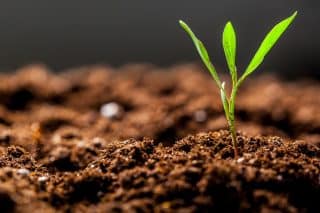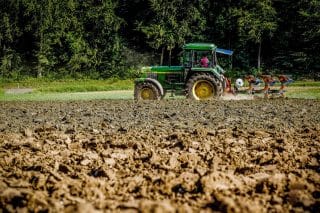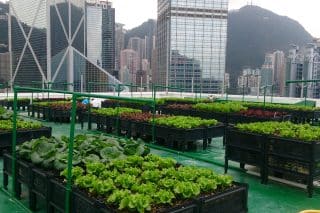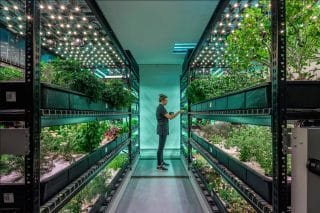During the Robotic Forum FIRA in Toulouse, farmers discussed current industry challenges and their thoughts on technology as a solution. Many agree that too much energy is used in agriculture and there needs to be an eco-friendly, sustainable food production process that boosts the economy for farmers. Here’s how smart management can generate more efficient farming.
The major cost of farming goes to the person sitting on the tractor, according to Professor Simon Blackmore, head of robotic agriculture at Harper Adams University in the UK. This point, not to mention the major decrease in workers—in the US, Great Britain and Europe—, is the root of the development of autonomous tractors and the management systems that farmers use to program, follow and analyse them.
The autonomous tractor does not roll alone. Smart farming involves a growing infrastructure driven by Big Data and the Internet of Things, including smart sensors, governance and management information systems. Blackmore admits that “all of it will certainly be disruptive to farmers and machinery manufacturers.”
However, the potential benefits—reduce labor cost, boost yield production, prevent the spreading of plant and animal maladies as well as health problems for workers, among other reasons—is why there are already many farmers involved in integrating such technology into their farm management.
As Blackmore explains, there is no one size fits all solution. Here at AgriExpo e-Magazine, we have discovered a number of possibly good fits.
Operational Management Systems
Many farmers have already moved away from documentation through Excel spreadsheets, integrating instead a digital data management system. Such digital platforms provide a more operational management solution—efficient as in it is less time consuming, more useful in terms of data sharing and often a digital record of all agricultural production processes.
365FarmNet is one such platform which supports planning, automated documentation, analysis of measures taken, monitoring and optimising all process steps. It also recommends and warns against animal sickness and conflictual measurements in the field. 365FarmNet is noted in Future Farming magazine to make “compliance with statutory certification requirements easier and more secure overall,” saving farmers time.
Farmers, if you’re using other platforms and would like to give your thoughts on those, please let us know!
Find an extensive list of Farm Management Software on Capterra here.
https://www.youtube.com/watch?v=dZXSXny-X4Q&feature=youtu.be
Smartphone and/or Tablet-based Systems for Recording
By utilizing our time more efficiently, we can actually economize. We all know that in certain cases we need to spend time in order to save a lot more time later. We can avoid production waste by taking the time to collect and analyse data during our farming procedures. Although many farmers already employ a Farm Management Information System (FMIS), many don’t find the time to analyse the data themselves, or they don’t fully trust the data.
This is why organized data collecting is essential for proper yield analysis. It will help farmers manage yield zones and identify trends. Software analysis tools provide farmers and agronomists visibility on past production for future production—should the same or a different approach be implemented to grow future crops? In addition to Operational Management Systems, many farmers use satellite guidance with recording capabilities.
The guidance system Blackbox Air by Patchwork records and stores field boundaries, area measurement and automatic field recognition; Agricision’s Ontrak records A-B lines and boundaries, calculates field sizes and records area worked, allowing farmers to adjust implement width. Machinery Guide is an App that farmers can use with the GPS receiver of their choice; it offers the ability to set up A-B lines, record individual jobs and has a digital lightbar and bout markers.
When using the eFarmer app, farmers can create straight or curved A-B lines, map fields and record the area worked. With the Marshal Multispread app by Roesner PTY, farmers can download and store up-to-date spreader calibration settings, adjust application rate, deliver variable applications and record spreading operations. Agco came out with IdealHarvest, a Combine operating system that fine-tunes threshing with separation and cleaning settings on the go, based on operator-set targets. It also has crop flow visualisation and can be operated through the Tech Touch terminal or a mobile device using the Agco’s SmartConnect app—it is unsure whether the data can be recorded or is used for real-time purposes.
The question remains: What else could the available software be recording to better assist farmers?
Your comments are welcome.
Digital Field Management: Every Plant Counts
The delivery of highly detailed field observations straight to a farmer’s tablet or computer will soon become a standard in agriculture, according to Crop Science by Bayer. With expertise in the integration of seed technology with chemical and biological crop protection, Bayer’s Crop Science division is currently working with engineering and electronics specialist Bosch to generate digital spraying technologies: Smart Spraying—sensors, analytics and selective spraying systems that will identify weeds and apply herbicides only where needed.
Together they plan to develop and incorporate a digital field manager to evaluate all weed situations and suggest precise treatment timing.
Read more about digital farming through Bayer’s research magazine.
Precision farming moves from the field at large to the single weed and plant. Blue River Technology incorporates computer vision, robotics and machine learning to smart machines in order to detect, identify and make management decisions in regards to each individual plant. Two notable technologies are See & Spray, a tractor-mounted crop sprayer that can identify weed typologies and apply the proper herbicide, and LettuceBot.
Clean Seed created a smart seeder using wireless, software-controlled precision seeding technology. The award-winning CX6 Smart Seeder has a static central delivery system which sends the seeds to pre-holding stations above each opener, and the seeder’s computer software platform SeedSync instructs the meters to release the inputs at specific times using wireless, industrial Bluetooth technology. Smart Seeder can release up to six products independently, at different rates.

CX6 Smart Seeder functions with a computer software platform, SeedSync, that can be controlled from any of your devices. Courtesy of Clean Seed.
Remote Monitoring for the Autonomous Tractor
At the FIRA in Toulouse we learned that Japanese manufacturer Kubota will put its fully autonomous tractor Agri Robo in the field this year to act as planters—available in Japan. The management operations software integrated in Agri Robo allows farmers to manage the autonomous tractors in real time. Along with Kubota, Japanese manufacturers Iseki and Yanmar feel the “one operator, two machines” concept is the next step for field operations.
Indian market leader Mahindra & Mahindra will soon release an autonomous system for its 20-100hp range, implementing the company’s own DiGi Sense telematics system. DiGi Sense has digital tracking and geofencing in addition to other points. Farmers can operate the vehicle via a tablet computer interface.

Read our article on autonomous tractors here. IDEAL by Fendt. Courtesy of Fendt.






